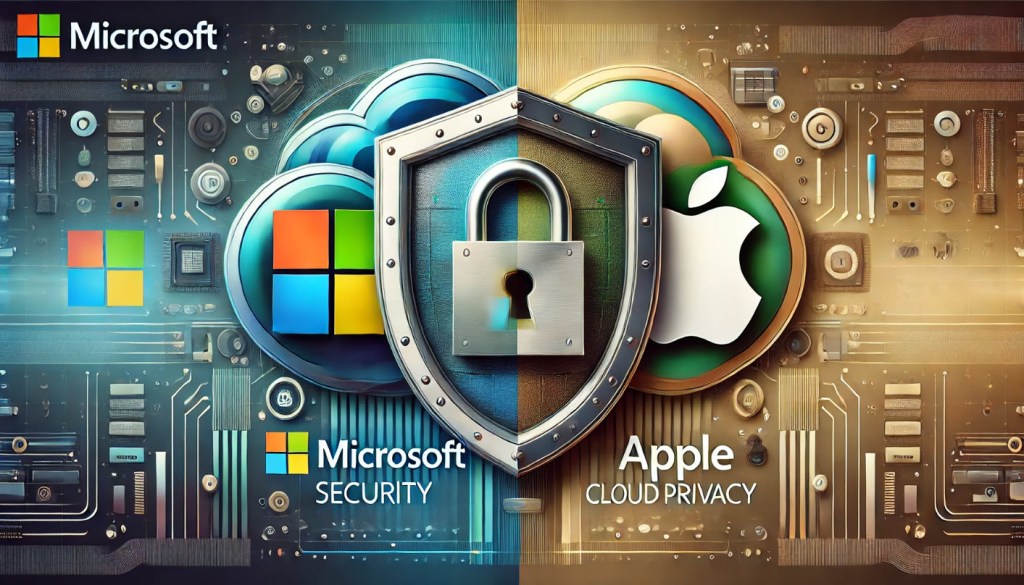Why Microsoft’s Security Initiative and Apple’s Cloud Privacy Matter

Join our daily and weekly newsletters for the latest updates and exclusive content on industry-leading AI coverage. Learn More
With cyber threats growing more automated and malicious, securing enterprise data and privacy has never been more challenging. Apple and Microsoft‘s new security initiatives capitalize on their core cloud security and privacy strengths to close security gaps and reduce risk for every business.
Microsoft’s Secure Future Initiative (SFI) and Apple’s Private Cloud Compute (PCC) represent the latest enterprise-ready approaches to improving cloud security and privacy. The larger the enterprise, the more diverse its cybersecurity and privacy needs, so SFI and PCC are designed to deliver real-time responses at scale.
Microsoft first unveiled the Secure Future Initiative (SFI) in Nov. 2023 to enhance its clients’ enterprise cloud security infrastructure. SFI’s goal is to deliver step-wise improvements in security across the Microsoft ecosystem. The company recently published its Secure Future Initiative Progress Report.
Apple launched its Private Cloud Compute (PCC) platform in June 2024. The PCC is a cloud intelligence system created specifically for private AI processing. Apple’s device-level security and privacy architecture is core to PCC and extended to cloud-based AI operations. One of the PCC’s primary design goals is to keep cloud-processed user data private. This is done with custom silicon, a hardened OS and privacy-preserving methods that manage data requests without storing data.
Microsoft’s Secure Future Initiative (SFI) is a multi-layered defense for enterprise security
At its foundation, SFI is designed to embed security into every layer of Microsoft products and services as part of its secure-by-design framework and more broadly speaking, a new security philosophy.
Microsoft’s Executive Vice President Takeshi Numoto recently said, “At Microsoft, security is our top priority, and through SFI, we ensure that our products and AI systems are secure, private and safe.” Microsoft reaffirmed its commitment to TrustWorthy AI with an announcement this week emphasizing responsible development and deployment of AI technologies.
Six engineering pillars form the foundation of Microsoft’s Secure Future Initiative (SFI) strategy. These pillars are designed to protect systems, data and identities while anticipating cybersecurity threats all from a common platform.
Three core principles define SFI. These include secure by design, secure by default and secure operations. Microsoft committed to these in their latest report, saying all product teams will be using these principles and adopting the Microsoft Security Development Lifecycle (SDL) as their development methodology.
Six engineering pillars make up Microsoft SFI:
- Protect identities and secrets. Securing identities is a critical focus of SFI, especially after the rise in identity-based breaches targeting Active Directory (AD), looking to take control of all identities in a company. Microsoft looks to significantly reduce enterprise identity-related attack surfaces by introducing phishing-resistant credentials and video-based identity verification.
- Protect tenants and isolate production systems. Microsoft designed SFI to strengthen network security by isolating production environments and improving compliance tracking. Also designed in are more stringent isolation policies across virtual networks and production systems to help prevent lateral movement of threats. Microsoft also vows to provide enhanced monitoring to ensure potential threats are identified and acted on quickly.
- Protect Networks. Core to SFI is improved monitoring of virtual networks by recording all assets in a central inventory and ensuring isolation between corporate and production networks. The teams who architected SFI are placing a high priority on enforcing micro-segmentation and minimizing the attack surface. A core construct of this area of SFI is that it ensures lateral movement within the network is limited and controlled, limiting the blast radius of a potential attack.
- Protect Engineering Systems. SFI’s architects chose to rely on the Zero Trust framework to protect Microsoft’s software development environments. Central to this approach is limiting the lifespan of personal access tokens and enforcing stringent checks during code development. Microsoft’s SFI contends that these measures help prevent unauthorized access and protect critical resources during the software development lifecycle.
- Monitor and Detect Threats. Real-time threat detection is the cornerstone of SFI. Microsoft’s SFI framework aims to enable all production systems to emit standardized security logs, providing timely visibility into network activities. This centralized logging enables faster identification of threats and helps enterprises proactively monitor malicious activities.
- Accelerate Response and Remediation. SFI also reduces threat identification and action time to address vulnerabilities quickly. Microsoft publishes critical vulnerabilities (CVEs) regardless of customer action, helping the industry adopt mitigation strategies faster. This proactive approach boosts cloud ecosystem security.
Apple’s Private Cloud Compute (PCC) has privacy at the core
While Microsoft concentrates on closing the gaps it sees across the cloud and entering infrastructure, Apple’s Private Cloud Compute (PCC) capitalizes on the company’s decades of R&D experience in privacy.
Apple invested years of research and development in PCC, looking to create a stateless architecture that could ensure the privacy of customers’ data at the silicon level, making it impossible for an insider attack inside the company to breach it.
Of the many design goals that define the PCC, one of the most important is scaling Apple’s industry-leading device privacy controls into cloud-based AI services. Apple’s central goal is to set a new standard for secure cloud intelligence.
Key features of PCC include the following:
- Stateless computation and enforceable privacy: PCC employs a unique stateless architecture that ensures sensitive data is processed only for its intended purpose and never retained after a process is complete. The stateless architecture is built on hardware-backed secure enclaves and cryptographic protocols to ensure data confidentiality during processing. PCC’s memory is non-persistent, with all data cryptographically erased upon request completion.
- No privileged access: PCC implemented a zero-trust model that prevents any privileged access that could potentially bypass privacy controls. Apple achieves this by using a combination of hardware-enforced isolation, secure boot processes and code-signing algorithms. PCC is designed with such stringent privileged access that Apple’s site reliability engineers cannot access user data or bypass security measures.
- Verifiable transparency to the log level. Cryptographically signed transparency logs of all software running on PCC nodes are published to enable third-party audits. The transparency logs are also used to verify that the code matches the reviewed software. Apple also provides a Virtual Research Environment for simulating PCC environments and offers bug bounties for discoveries across the entire PCC stack.
- Custom silicon and hardened OS. PCC leverages custom Apple silicon with built-in security features like the Secure Enclave and a hardened subset of iOS and macOS. This ensures that user data is processed in isolated environments with hardware-enforced security boundaries.
- Oblivious HTTP routing: PCC requests go through an independent Oblivious HTTP relay. This hides the request origin, preventing IP address-person correlation.
Apple also designed end-to-end encryption, advanced anonymization techniques to protect data throughout its lifecycle, advanced access controls, and support for multi-factor authentication. The PCC also has real-time threat detection and supports regular security audits and penetration testing. For a thorough analysis of the PCC platform, see VentureBeat’s recent in-depth analysis.
Security and privacy comparison: Microsoft SFI vs. Apple PCC
IT and security teams are too busy to manage another platform. Microsoft and Apple are embedding security into their architectures to reduce this burden.
SFI is how Microsoft is integrating security into Azure and Microsoft 365 at every layer. Hardware-level privacy protections in Apple’s Private Cloud Compute (PCC) boost privacy. Both methods simplify critical security measures to keep teams safe without adding work.
The following comparison is a short guide to help IT and security teams gain insights into the differences between each platform:
Cloud security and threat model
- Apple PCC: Designed for secure AI cloud processing, it aims to prevent data leakage, insider threats, and targeted attacks, with robust measures to ensure privacy and security in cloud environments, according to Apple’s PCC blog post released earlier this year.
- Microsoft SFI: Focuses on reducing the attack surfaces across all Microsoft tenants and production environments, with a specific aim of preventing lateral movement between environments. SFI aligns with Zero Trust, a framework that assumes a breach has already happened and requires continuous verification of user and device identity, regardless of network location. Azure and Microsoft 365 ecosystems are protected by Zero Trust. For more information on the Zero Trust framework see the NIST standard, Special Publication 800-207, which outlines the key principles of Zero Trust Architecture (ZTA).
Cultural Integration
- Apple PCC: Prioritizes privacy through technical design rather than cultural changes. Privacy is embedded in both the hardware (Apple silicon) and software (iOS/macOS), ensuring secure-by-design architecture without needing broad cultural shifts.
- Microsoft SFI: Security is embedded into all operations, from corporate governance to employee evaluations. The Microsoft Cybersecurity Governance Council plays a key role in ensuring risk management is consistent across the company.
Scope and Focus:
- Apple PCC: Focuses on AI privacy in cloud, multi-cloud and hybrid cloud environments. It is designed specifically for businesses seeking security and privacy assurances in AI applications, offering high levels of security for AI processing and data storage.
- Microsoft SFI: Microsoft’s product and services-wide initiative to engrain security into the DNA of every product and service they offer. A comprehensive security framework that spans identity management, governance, employee training, and technical safeguards across its ecosystem, including Azure and Microsoft 365. It aims to secure all layers of its platform and user base.
Technical Implementation:
- Apple PCC: Apple secures its framework with custom server hardware and silicon. Stateless computation reduces risks by not storing data between sessions. AI data privacy is a primary design goal by having an integrated hardware and software design. With privacy protections at its core, Apple’s goal is to make PCC-based AI processing secure.
- Microsoft SFI: Microsoft’s strategy weaves security into every phase of software development through a Secure Development Lifecycle (SDL), ensuring that security measures are incorporated from the design stage to deployment. CodeQL, an automated code analysis tool, meticulously scans for vulnerabilities within the code. Moreover, robust identity protection is guaranteed via MSAL (Microsoft Authentication Library), which oversees secure authentication and token management across various applications and services.
Transparency and Governance:
- Apple PCC: Researchers can audit Apple’s systems and view its AI processing environments in cryptographically signed transparency logs. Accountability allows businesses to evaluate and trust Apple’s AI infrastructure without compromising sensitive data.
- Microsoft SFI: Microsoft’s Secure Future Initiative (SFI) seeks to improve security transparency and cybersecurity across its products and services. Advanced security features like Azure Active Directory Conditional Access and Microsoft Defender for Cloud use machine learning algorithms to detect and respond to threats in real time. The company also launched Cyber Signals to provide threat intelligence insights and a Customer Security Management Office (CSMO) to improve security incident communication. These initiatives are promising, but Microsoft’s handling of critical system flaws and data breaches shows the ongoing challenges of scaling cybersecurity.
Why Microsoft SFI and Apple PCC signal a shift in enterprise security
Realizing that IT and security teams are overstretched already, and no one needs another platform to look after, Microsoft and Apple have taken unique approaches to make security and privacy the core of their DNA.
For many IT and security leaders, these two platforms are overdue. SFI is a strong attempt to change the security of Microsoft DNA at its core. As the first generation of an entirely new era of security, SFI is comprehensive and sets the structure so security can become part of its DNA. Starting with the areas that are the most challenging for IT and security to deal with, SFI takes on the challenges of identity management, governance, and technical safeguards.
Apple’s continual investments in privacy pay dividends in PCC. Their prioritizing AI cloud privacy, and embedding privacy protections directly into silicon and operating system software make them unlike any other platform vendors offering privacy at scale.




Comments are closed, but trackbacks and pingbacks are open.